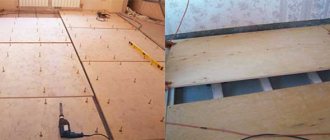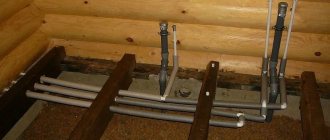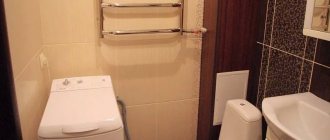Advantages of a garage in the basement
For most vehicle owners, it doesn’t matter where the garage is located, in an extension or in a semi-basement version of the premises. The main thing is that entry into and exit from the garage to the site is as convenient as possible, and normal conditions for storing equipment are ensured.
The garage in the basement is of interest from an architectural and design point of view:
- Visually, the building looks more compact and neat, without unsightly extensions and additions;
- The location of the garage at the basement level makes it possible to classify the entire first floor as semi-basement and basement premises, which means it is possible to artificially increase the number of storeys of the building without additional permits from supervisory authorities;
- The presence of a recessed version of the garage has virtually no effect on the appearance of the building facade. Thanks to the plinth, the elements of the gate and decoration are practically invisible or only slightly visible, while maintaining the comfort of arrival without additional maneuvers around the site.
Important! The presence of a room at the basement level worsens the operating conditions of the waterproofing, since a significant area of the foundation system occupied by the garage has to be reinforced with waterproofing barriers against soaking.
In addition, in most cases, when the entrance gate is open, it is almost impossible to see what exactly is happening inside the garage, since the driveway covers most of the space. For car enthusiasts, one of the most attractive features of storing a car in the basement of the house is easy and quick access to the garage compartment through internal doors.
Car lift
Such a convenient innovation as a car lift, also known as a “car lift,” is gradually gaining popularity in our latitudes.
And it can be installed in a basement garage.
Although this option is not cheap, it is extremely convenient.
If the width of the room does not allow for a garage for several cars, and the family has more than one car, then a car lift is a godsend.
These lifts operate using electricity or hydraulics.
The autolift platform can be equipped with additional safety devices (motion sensors) and have various finishing options. You can park another car on the car elevator platform.
The underground space can be designed for both two cars and for storing various equipment.
The lift can be controlled both from a stationary device and from a remote control. Or a combined control option is installed.
Features and advantages of autolifts:
- high safety of machine movement
- there is a hydraulic system valve rupture safety device
- there are overload indicators
- corrugated non-slip platform floor
Basement garage in a private house - photo gallery
Parameters and technical characteristics of car elevators (approximate)
Device type | Lifting speed(m/s) | Nom. load(kg) | Cabin size(m) | Shaft size(m) | Doorway(m) |
Disadvantages of building a garage located in the basement of the building
In addition to the listed advantages of the basement location of the garage, there are certain difficulties directly related to the fact that there is a car storage room in the basement of the house:
- A gap in the foundation strip and plinth due to the arrangement of the entrance gate leads to a redistribution of the load to other areas of the foundation. In this regard, the study of the bearing capacity of the soil should be carried out only by specialized specialists;
- Due to the low base and large contact area of the garage walls with soil and soil water, the use of exceptionally powerful and high-quality external waterproofing and powerful indoor ventilation is required. In addition, special measures are required for rainwater drainage in the area of the entrance gate and the platform before entering the garage;
- The lower level of the room relative to the ground promotes the accumulation of gases and vapors associated with the maintenance of equipment and the operation of the machine engine. To block the penetration of vapors from the basement level to the upper floors, additional sealing of cracks and joints in the floor slabs will be required.
For your information! With rare exceptions, for a garage located in a basement or basement, only lifting types of gates are used; swinging structures are usually not used due to the fact that the surface level of the area in front of the gate is usually higher than the threshold.
If the garage is not heated, additional measures must be taken to insulate the edge parts of the foundation adjacent to the base and the garage room.
Where can you build?
You can build a garage, based on Article 51 of the Civil Code of the Russian Federation, in the following areas:
Allocated for individual housing construction (clause 17.1.1).- Not intended for business activities (clause 17.1);
- Defined on the basis of legislation in the field of horticulture and gardening as garden plots (clause 17.1).
- Belonging to a garage-construction cooperative. In this case, the garage is transferred into the ownership of the owner after full payment of the share contribution (Part 4 of Article 218 of the Civil Code of the Russian Federation).
In addition, permission is not required for the construction of non-permanent buildings, in other words, garages without a foundation and utilities (clause 17.2). However, it should be understood that such a structure will be extremely unstable and the risk of its destruction is extremely high.
Installation of garages near apartment buildings on territory that is not private property is considered as self-building. But this does not mean that the construction of such a building cannot be legalized. Such a procedure is possible, but it requires a lot of time and effort.
Is it convenient to use a garage located at the basement level?
Most owners find this arrangement of the car storage area quite convenient. In the summer, thanks to good ventilation, there is no dampness in the room, but there is a dry, comfortable coolness. Whereas in most above-ground garages it is very hot in the summer heat.
Storing a car in a semi-basement or basement is not very convenient for carrying out repair work on the suspension and underbody of the car. A thick slab and a thick layer of bottom waterproofing make it almost impossible to construct an inspection hole, and the small ceiling height of 2.5-2.8 m makes it very difficult to use lifts or tippers.
Disadvantages also include the need to build a special entrance to the garage in the form of an inclined platform or ramp, which, accordingly, changes the profile of the local area. Along the side lines and the foundation blind area, it will be necessary to install a very powerful underground storm drain, since the natural slope of the ramp will lead to the redirection of rainwater flows to the garage door. In some cases, it is necessary to build high parapets along the entrance to the garage to prevent leakage. In winter, the pit of the ramp in front of the garage is an ideal place for a snowdrift as tall as a man.
Security
Fire safety requirements differ depending on the material of the garage building. Keeping the distance according to SNiP is necessary not only for the comfort of neighbors, but for the purpose of fire safety.
If the recommended distance between the garage and a neighboring residential building should be at least 6 meters, then, in the case of wooden buildings, it increases up to 15 meters. This will ensure the safety of people and material objects in the event of a fire in the premises.
Despite this, it is possible to reduce the distance to the usual.
Garage drawing.
For this purpose, you will need to follow several important rules:
- install at least one fire extinguisher;
- organize a fire shield;
- place a container with sand next to the building;
- refuse open type heaters;
- cover the lamps with a special shade;
- protect the wiring by laying it inside a metal cable;
- keep track of electricity by connecting to a meter installed in the house;
- organize automatic fuses.
Basement with garage on a slope
One of the most interesting options for implementing a garage in the basement is the use of the natural sloping terrain. The most convenient for arranging a garage located in the basement of the house will be a slope or slope of the surface with an angle of 8-15o. On flatter terrain, there is no noticeable effect from the basement location of the room for the car; with steeper slopes of the hill, the house often has to be designed in the form of terraces using pile supports.
Construction of a plinth on a slope
The presence of a slope makes it possible to reduce the amount of excavation work required to construct a foundation pit for a building. To level the site for the foundation, it is necessary to make a vertical cut of the slope under the rear wall of the plinth and part of its foundation, then a bulldozer simply removes part of the soil, and the leveling is carried out for the base of the building.
Installing a house with a basement garage on a hillside usually requires very serious protective measures to prevent the top layers of soil from sliding onto the rear wall of the building. As a rule, foundations for such houses are built from FBS blocks to a depth of at least 2.5-3 m. Part of the base of the blocks is artificially raised above ground level to ensure retention of the upper layers of soil hanging over the building frame.
After the basement of the building is completed, the back of the house will be almost completely buried in the ground, the facade with the basement and garage will be almost completely on the surface. In addition, the driveway and the area in front of the garage will have a slope directed away from the foundation, which will provide excellent drainage and a certain convenience when leaving the premises. During periods of intense snowfall, the area in front of the entrance is not covered with snow or flooded with melt water.
Advantages of a basement garage on a slope
We can say that for buildings on a slope, the location of the car room in the basement is a successful combination of the advantages of a semi-basement and a regular garage room. There are no problems with snow and rainwater, but the temperature inside remains stable, cool in summer and warm in winter.
With the correct arrangement of the foundation made of concrete blocks, it is possible to install additional windows or ventilation ducts in the walls. With good thermal and sound insulation of the ceiling, any, even the most active work does not create discomfort for the inhabitants of the house.
For such a semi-basement, you can use any type of gate, from swing to sliding. It is possible to equip a platform and a carport for parking a car, which is almost impossible for most classically designed basements.
Will the court solve the problem of installing a garage in the yard?
If you achieve a positive court decision, then neither the municipality nor your neighbors will be able to remove your garage. But, in order to submit documents to the court, you must receive a refusal from the municipal authorities.
If you are sure that your garage complies with all building standards and does not threaten people, then the court may make a positive verdict and oblige Rosreestr to issue ownership of the garage.
It is better to contact a good lawyer to resolve all the legal subtleties. Often, a legal garage in the courtyard of a high-rise building will cost the same as a spacious country cottage.
Therefore, today there is no alternative to self-building. Buy a collapsible sectional metal garage, and then “time will tell.”
GEOMETRY AND DIMENSIONS OF THE PLOT
If the building is centrally located or the building area is shifted to the far boundary, it is more logical to consider a detached garage (or shed) located at its nearest boundary. When shifted to the nearest one - a built-in or attached type of garage. With this arrangement, the green area is not “injured” by access roads, turning points and passing places for cars, however, with the large size of the plot, this reasoning is not taken into account; on the contrary, a spectacular turning area in the center can become the starting element in the concept of landscape design.
EXAMPLE of placing a garage on a site
- Project Mirabell 3.2 (527 sq.m.)
- The area of the plot is 10 acres.
A. Garage attached to the house: courtyard - 3.78 acres.
B. Detached garage: courtyard - 2.3 acres.
What does the law say?
a Town Planning Code in Russia
, one of the most complex and largest regulations in the country. Article 51 of the document states that a construction permit is required for any objects being built in populated areas or outside them. Issuance is preceded by verification of papers and applications prepared by the applicant.
The output is an impressive list of documents
:
- design documentation that meets urban planning requirements;
- land surveying and planning projects;
- allotment of land.
Important nuance! The land plot must meet the construction purposes
. The body that has the right to give permission is local government. This is where you need to go even before you start designing your future garage. If there are no permits for an object, it cannot be registered with Rosreestr. This means that the demolition of such a structure is a matter of time.
So, you will have to pay for design documentation (several tens of thousands of rubles), allotments and surveys. And also for renting or buying a plot. As a result, in a big city, the issue of building a garage, by law, becomes simply futile. Who is ready to shell out several hundred thousand rubles?
, if for this money you can buy several boxes in a cooperative?
Read more about garage waterproofing
Garage waterproofing
You can protect this room from moisture yourself - to do this you need to arm yourself with a drill with various attachments, screws and waterproofing material. The role of the latter is roofing felt: it will form an insulating layer through which moisture will not penetrate. You need to cover the walls and floor with this material, fixing the roofing felt sheets with self-tapping screws.
If particularly strong protection is required (when humidity is high), filter pads can be installed on the walls and floor. They are mounted directly on roofing felt and are quite an effective aid. After that, all this waterproofing (both with and without a cushion) must be covered with a reinforcing mesh and the walls, ceiling, and floor must be plastered so that all surfaces are smooth and ready for use or painting.











